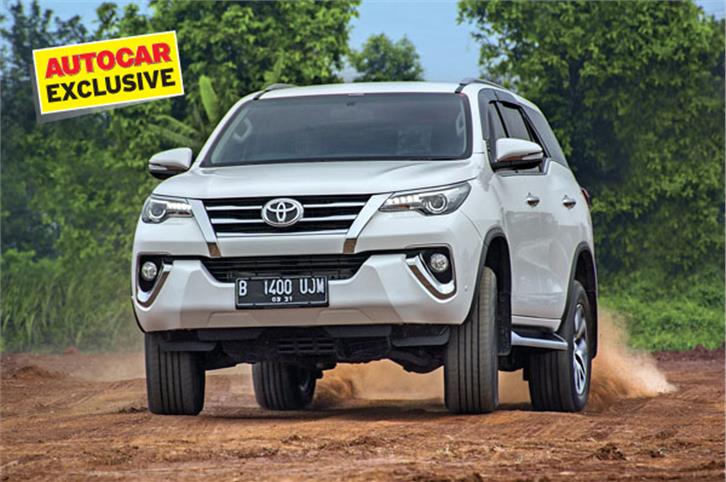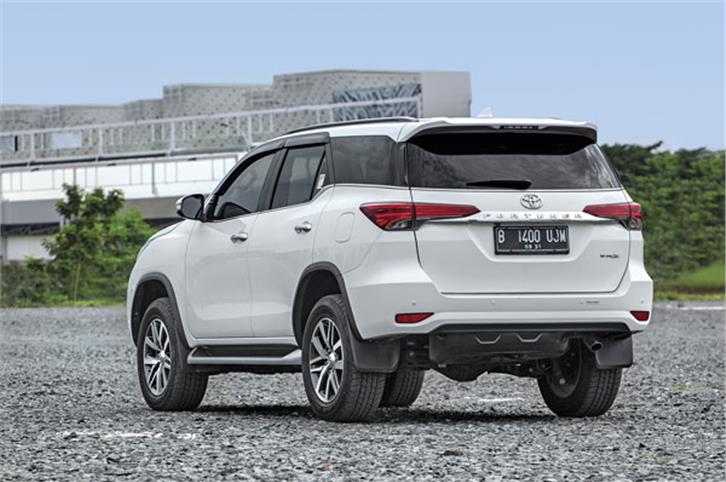New 2016 Toyota Fortuner review, test drive
Toyota’s all-new Fortuner is coming this November to stake its claim as king of its class. We get behind the wheel.
Published on Oct 27, 2016 03:20:00 PM
1,55,572 Views
Follow us on


The Fortuner looks best when viewed from the rear three-quarters.

The ride is much flatter and more settled, and it even feels a bit more agile around corners.
Road roller
I head out again, but this time, onto regular, sealed roads outside the massive construction site I’ve been driving in and around. Time to pay attention to things like driving position, general visibility and ease of manoeuvrability; all of which are surprisingly good. I don’t say this lightly, because Jakarta has traffic patterns very similar to our own, with bikers jinking in and out and cars always trying to give you the ‘squeeze’. And what makes things easier is the fact that the driving position is great. The seat is powered, the steering wheel adjusts for reach and rake and even visibility out the rear is quite good, due to all that glass at the back and the nicely set-up reversing camera.
The rear-wheel-drive only version I’m driving is powered by the smaller 2.4-litre motor that will also propel the new Innova back home in India. Known as the 2GD-FTV, it puts out 150hp and is mated to Toyota’s new AC60 six-speed automatic. Idle is a bit gravelly and though it isn’t too loud, this is clearly a diesel. Refinement levels, however, improve as soon as I set off from rest. The engine smoothens up quite nicely around 2,200rpm, there isn’t much turbo lag and a meaty slug of torque comes in at around the same time, making it comfortable to drive at city speeds.
The new diesel engine also spins smoothly to 3,000rpm, with a linear increase in power and torque, which makes the new Fortuner shift quite smartly. In fact, the engine pulls pretty well till around 3,800rpm, but demanding more power and performance after that comes with a few penalties. The motor strains hard, gets quite vocal and performance isn’t very strong either. And what’s not nice is that the din gets louder still as you approach 4,500rpm. So, while I find that driving the Fortuner 2.4 in city traffic is quite effortless and cruising on open highways even at relatively high speeds is easily manageable, overtaking, even in fast-flowing traffic, is a bit of a chore. You have to plan your moves well in advance, you have to be patient and if the car in question decides it doesn’t want to be overtaken, you could be in for a bit of a dice. As on the Innova, there are three driving modes; Eco, Normal and Power, and for faster traffic, it’s best to use Power, that significantly improves the amount of grunt you have at lower and medium engine speeds.
Thankfully, we’ll also get the more powerful 177hp 2.8-litre diesel in India, and performance with that engine will be much stronger. It has 27hp more power and a lot more torque, so, it should be much quicker and importantly, more effortless. Toyota will launch the 2.4-litre version too at a later stage, but we suggest you only look at it if you are chauffeur driven.
What impresses me much more is the new Fortuner’s ride and handling. The new chassis is clearly stiffer and, as a result, the redone suspension needs to work less to deliver the same amount of suppleness or grip. This has allowed Toyota to use slightly softer springs and more absorbent dampers, improving the ride quality of the new Fortuner.
This is demonstrated time and time again over some of the less-than-perfect roads we encounter in Jakarta. Even though some of the sections are quite bad, the Fortuner just seems to glide over them more often than not. Larger holes and deeper ruts do cause it to display some of its underlying stiffness and the destabilising effect of all the unsprung mass being flung around (the heavy wheels and heavy suspension arms) is still felt too, but that rocking, always-on-the-move ride quality associated with the earlier Fortuner currently sold here has been largely eradicated.
What the new Fortuner also manages to do, quite nonchalantly, is remain unfazed at speed. Jakarta’s intra-city highways are four lanes wide and super quick and I’m genuinely impressed with how easily it copes with the speed. Remember, this is a full-on body-on-frame SUV with a 225mm ground clearance and 700mm of water-wading ability. And that means most of the heavy bits are up there on the second floor. But the new Fortuner, in fact, is so stable, it holds on to extremely high speeds with almost no additional input at the wheel. Still, impressive high-speed stability isn’t the Fortuner’s only party trick. Toyota has also improved the new Fortuner’s brakes by a fair margin. The new Fortuner gets 17-inch discs at the front and stopping power, bite and pedal modulation are much improved. I find myself braking with plenty of confidence deep into corners, allowing myself to carry an impressive amount of speed into corners and the brakes help deliver plenty of peace of mind in free-flowing traffic too, where you need the extra bite to stop this beast in a hurry.
What’s also much improved is handling. Yes, the new Fortuner still rolls like the Titanic and this is a bit disconcerting initially, but the new, stiffer chassis, better-balanced suspension and the nicer steering all contribute to make this car reasonably agile to drive, even over something like a winding road. And this, quite honestly, comes as a bit of a shock. No, it isn’t quite up there with competition like the Endeavour and it still is big, heavy and sometimes quite ponderous. But like that fat man who can dance, it has a fairly good sense of balance. And that makes it so much more relaxing to drive in corners. The steering, though good at speed, remains heavy at city speeds and this can be quite an irritant if you want to swap lanes in slow traffic. The Ford Endeavour’s much lighter steering helps mask its bulk much better.
Copyright (c) Autocar India. All rights reserved.





Comments
Member Login
Personal Details
No comments yet. Be the first to comment.